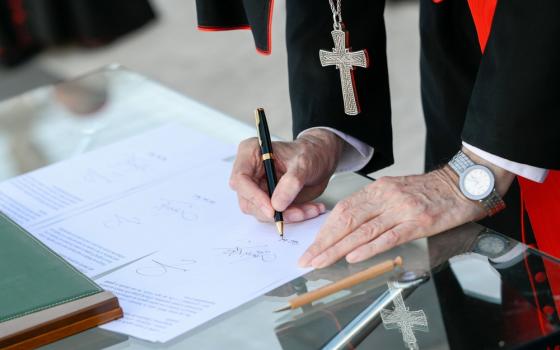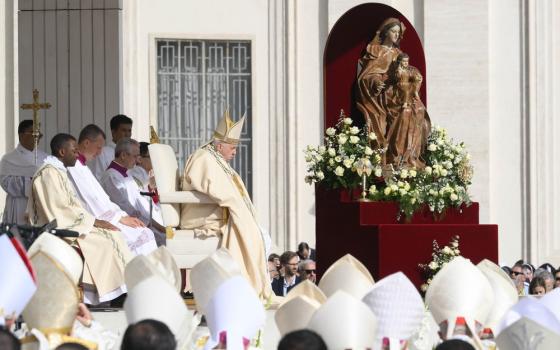
Essay
We find ourselves in a deeply divided church -- and society as well. For those who love the church, the many contemporary trials Catholics face cause concern and, for some at least, pain. Some trials, with origins stretching back 400 years, are manifest in an increasingly secularized society. Other trials are more contemporary and play out in criminal and civil courts. But in his poignant appeal for help Pope Benedict XVI saw that the present dark state of affairs goes much further and deeper: "What went wrong ... in our entire way of living the Christian life to allow such a thing to happen?"
If so, then the question is: Where do we go from here? Some, often called "dwellers," look back to a seemingly secure past, but struggle in coming to terms with the present. Others, often called "seekers," in looking forward, struggle with assuring the essentials of the tradition. Most, social analysts report, find themselves between the two poles, attempting to live more fully the essential truths of Christianity in a way that is sensitive to, but not dominated by, the circumstances of our time. For all three, a quite new level of cooperation between a set of leading Catholic research clusters promises to be a reason for hope for all in the church.
The dark night
I would suggest that the task must be carried out, not despite, but in terms of the suffering. Here the example of Martin Luther King Jr. seems relevant. Overwhelmed by the oppression of his people, he turned to the theology of Paul Tillich, who had made an integral place in his theology of salvation for the tragedies of the two world wars. The darkness was not to be ignored or escaped; indeed, it was only through facing the darkness that "we shall overcome someday." With that insight King was able to face down fire hoses and police dogs, mobilize a country and indeed overcome, finally through death.
Similarly, in the midst of the present church crises Charles Taylor, author of A Secular Age, sat down and traced out the four quadrants of the ever-growing disjunction between church and people. As revealed by his detailed investigation of the emergence of a secular age through the last 400 years, these offer more precise understanding of our problems and help to guide a coordinated response.
The first disjunction regards the seekers who launch out beyond the church, often in search of seemingly more authentic but perhaps less conscious paths to God. The second is alienation from the church's magisterium or teaching practice as it increasingly took on a more legislative tone that required obedience in a world accustomed only to critical attention. The third disjunction may be the most keenly felt, namely the less adaptive character of a natural law morality in a world sensitized to progressive change, particularly in the area of sexuality. Finally, a fourth disjunction opens as a plurality of spiritualities become evident through our new global awareness of the many religious traditions, as well as for the many who consider themselves to be "spiritual but not religious."
This laid out a topography of the present problematic: Each quadrant offers its own challenge and calls for its own approach, but in clear interdependence with one another as together they move from people to church and from moral practice to spiritual life. This agenda was taken up last June in a meeting at the Institute for Human Sciences in Vienna, Austria. The meeting brought together scholars from North America, the British Isles and across Europe for an intensive exploration of these four problematics. Their papers are now published under the title Church and People: Disjunctions in a Secular Age by the Council for Research in Values and Philosophy. At each disjunction, they push deeply into the dark night in which the church now finds itself and into the reasons for the growing sense of disaffiliation, even of the many who remain in the church. The reasons go deep, sociologically, historically and metaphysically; they rend the heart of anyone devoted to the church.
The new dawn
Nevertheless, in the divine providence that turns darkness into light these growing disjunctions can be seen to serve two truly essential roles. The first is to strip away accretions from the past that are no longer appropriate for our times. Indeed, the horizons of humanity have been inverted such that the divine is no longer reflected by an emperor king who alone decides for all his subjects. Instead, power now is generally seen to originate from the people or more deeply with God working immanently within hearts and minds, and to emerge therefrom in a creative and transforming manner. It would be counterproductive for the church to suggest a disenfranchisement of people who for all their days have been socialized by the language of personal freedom, responsible self-assertion and critical thinking, or to suggest that by baptism one enters a strange nondemocratic realm. Human symbols that four centuries ago bespoke a relation to a transcendent God can now distract from the loving, inspirational and immanent support of the One who shares in our struggles on his cross -- and of our lives as sharing in these struggles. The image of the self-emptying Christ (Philippians 2:6-11) helps to strip away what may now be counterproductive remnants from the past in our sacred symbol system.
But it does much more, for it offers new capacities for understanding and responding to an opposite dynamism that begins in the working of the Holy Spirit in heart and mind and is closer to us than we are to ourselves. This is an epiphany for a new evangelization that is much more readily preached and with a much greater chance of enabling a reset of our compasses in the direction of the new dawn of the light of Christ. Thus the review of the four growing disjunctions between church and people, far from being a negative exercise, helps orient our path ahead.
Just as wise professors know that the future of their field lies not in their own interests but in those of their graduate students, the first disjunction suggests an end to bemoaning a secularization that has emptied church pews. Those who have decamped to seek their own path raise the fascinating question of what they are seeking and where they are heading. They are the church's forward scouts, who can help to better orient pastoral efforts. The really pressing issue is not where we have been or what we were, but where we are heading and what, by God's grace, we are meant to become in his image and as his manifestation here and in our time. This is the fundamental importance of all four disjunctions.
 Correspondingly, for the dwellers, the newest insights of sociologists of religion Jürgen Habermas and Robert Bellah point up the religious importance of community and hence of the church. This offers an essential corrective for an excessive individualism, helps explain why half of those leaving the Catholic church join another congregation, and suggests the pastoral importance of the liturgy.
Correspondingly, for the dwellers, the newest insights of sociologists of religion Jürgen Habermas and Robert Bellah point up the religious importance of community and hence of the church. This offers an essential corrective for an excessive individualism, helps explain why half of those leaving the Catholic church join another congregation, and suggests the pastoral importance of the liturgy.
The direction for a response to the second disjunction regarding the mode of the church's work as teacher is also illumined in the faint glimmer of the new dawn. The more its teaching came to descend from a single earthly center, the less able it became in these complex and ever-changing circumstances to cooperate with the working of the Holy Spirit in the hearts and minds of all. This had been on the agenda of Vatican I when the threat of war cut it short. Now the magisterium must add more of the experience and insights of the faithful in order to find not only direction, but credible and convincing strength as the corporate voice of the entire body of Christ, a sense especially alive in the Eastern churches. This will require as well the new understandings of social dynamics and educational practice being uncovered by a broad swath of scientific investigations.
The third disjunction concerns the content of the moral teaching of the church, especially its teaching on sexual ethics. As with all sciences, ethics looks for knowledge that is universal and unchanging. Hence, it has been attracted too exclusively to the truths of human nature that remain ever true, but at the expense of the unique personal life lived by each individual in ever-deepening and evolving relations. Time, personal history and differences in entire cultural contexts need now to be integrated into this important key to individual and social self-understanding and interaction. The kenotic sense of Christ on the cross sharing the suffering of everyone as they face the moral dilemmas of life could help to develop a more adequate moral compass if it could be better understood and elaborated philosophically and theologically.
Finally, in the fourth disjunction the plural spiritualities that now open before us, recall the words to Peter at Joppa in Acts 10, where he was instructed to eat what previously had been considered profane. The great spiritual traditions of Asia lived immemorially by vast sectors of humanity provide deep experience of the divine inspirations and the human aspirations in the Spirit. Nor must we be overly pessimistic regarding the efforts of seekers who explore new human possibilities for awareness of God, even in their self-conscious efforts to do so in their own way.
In sum, the four disjunctions give us beginning points for reestablishing a credible proclamation of the Gospel for these new and global times.
Method for the task ahead
The progressive yet healing task just described is a daunting one that requires an extensive coordinated effort. How can such a task be undertaken?
In the preface to his Discourse on Method, René Descartes argued that, like city planning, this would best be carried out by a single mind working alone. This became the preferred method of modern rationalist science, which shrinks life to the requirements for mathematical clarity.
But in 1970 Jacques Monod published Chance and Necessity, a landmark challenge that the origins of life could be explained as purely a product of chance. A task force assembled in response by the International Federation of Catholic Universities concluded not only that it had no answer but that, despite the massive resources of Catholic learning and its thousands of scholars in each discipline, it had no structure for bringing to bear the multiple competencies required to search for related understanding. Thus it convoked a workshop at the University of Salamanca in Spain that traced out a plan, too long delayed, for bringing together in teams specialists from relevant disciplines to work on specific issues.
But the four disjunctions now require the yet further step of calling together not one but a set of such teams of scholars from the world's major centers of Catholic learning in a uniquely broad network. Here the work is not that of an individual or even of a single research team, but of a task force made up of a set of teams working in a coordinated manner. In the separate darknesses of the four interconnected disjunctions, the research teams are oriented by the predawn of the risen Christ. Seizing the opportunity to better appreciate the meaning for the church today of Christ as suffering servant on the cross, their goal is a proclamation of the Gospel that is a credible, insightful and attractive voice for our times. The story of their effort promises to be a gripping narrative.
Moreover, the practical side of this may be even more exciting, for it entails the church's healing its disjunctions or separations from the people to which it has been sent. Though these were perhaps inevitable in the early days of persecution or for pragmatic reasons in the face of religious wars, our secular age calls for the church to move closer to its people and join them in their pilgrimage. This will require a reversal of attitude and theology toward not only private but public life. For if the structures for public education and administration are the work of the people of God in their holy mission of educating their young and providing a decent civil context for all, then that must be where the Holy Spirit is working. If so, then that is where the church is called to serve, not as power or authority, but as leaven with the Gospel values of unity and harmony, justice and compassion.
What emerges then from the present compounded darknesses in this predawn is surprising indeed and, like the coming of the Messiah, it is counterintuitive. It is that the church's present alienation, if read in terms also of a theology of Christ pouring himself out on the cross as suffering servant, points the way to healing its current disjunctions from the people. This, in turn, can open the way for a truly new evangelization not only for the private realm of a remnant anawim, but for the public realm as well if that be understood as the work as God's holy people.
This is the effort now being assembled by the Council for Research in Values and Philosophy, with teams from North America, Europe and Asia. In its present crises the church truly calls out for help. The scholarly means for a response are not ready-made, but they do exist in dispersion. If marshaled and coordinated for a creative effort, they can help to find the way ahead for a church that images Christ as the suffering servant of a global world.
[Fr. George F. McLean, an Oblate of Mary Immaculate and professor emeritus of philosophy at The Catholic University of America, is founder and director of Catholic University's Center for the Study of Culture and Values and founder and president of the Council for Research in Values and Philosophy.]
On the Web
Copies of Church and People: Disjunctions in a Secular Age by the Council for Research in Values and Philosophy are available both in print and on the council's website.



